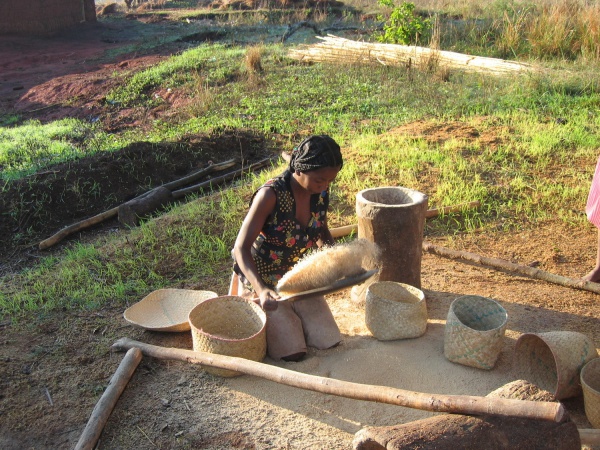Difference between revisions of "Vary"
CampMaster (talk | contribs) |
|||
| Line 16: | Line 16: | ||
[[File:Vary 006.jpg|600px]] | [[File:Vary 006.jpg|600px]] | ||
| + | |||
| + | == Rice - the staple food of Madagascar == | ||
| + | '''Text from Passport for Madagascar - 56th edition, January/February 2010 ''' | ||
| + | |||
| + | If ever two destinies werde bound to be linked to each other, they are the Malagasies and rice and, if the former cannot go without this food to live, it can only growh through the care of the latter. | ||
| + | |||
| + | In Madagascar, rice is the staple food of the people, accustomed for centuries to consume so much that its shortage is considered a humanitarian disaser. Because for generations, the Malagasy stomach requires its daily ration of rice, three times if possible, but the essential to have eat it at least once. That is why we still feel a little hungry after a plateful of food substitutes such as bread, sweet potatoes, cassava or corn because we always feel the need to eat rice, even if only a few mouthfuls, to obtain the desired feeling of fullness. | ||
| + | |||
| + | Essential food for life, rice has become a strategic commodity and a political tool for ensuring the reign of social harmony which must be able to supply sufficient quantities to people for whom a day without rice is synonymous with famine. | ||
| + | |||
| + | An ancenstral product, rice is still grown using the same age old techniques because there are immutable imperatives to be observed if the harvest is not to be compromised. Indeed for the culture to succeed, it must fulfil each of the obligatory stages: ploughing, irrigation of the fields, levelling the earth ready for planting, transplanting seedlings, weeding, the fight against insect predators, while awaiting the maturity of the ears of grain appearing after three to four months of work. So far, despite the technical progress made, no one has managed to modify these steps for rice cultivation, however, improvements have enabled progress such as the discovery of fast-growing varieties resistant against the attacks fo parasites, the enrichment of soil with improved fertilizers, giving higher annual yields. | ||
| + | |||
| + | From this rice has been created a variety of dishes, ranging from the simples to the most elaborate, requiring several hours of preparation. | ||
Revision as of 06:15, 5 April 2020
Vary is the Malagasy word for rice. On Madagascar rice is usually eaten several times a day, often being the only staple food which is available. On average, a Malagasy person eats over 130kg rice per year, which makes Madagascar the top rice consuming nation per person in the world.

| ||

|

|

|

| ||

| ||
Rice - the staple food of Madagascar
Text from Passport for Madagascar - 56th edition, January/February 2010
If ever two destinies werde bound to be linked to each other, they are the Malagasies and rice and, if the former cannot go without this food to live, it can only growh through the care of the latter.
In Madagascar, rice is the staple food of the people, accustomed for centuries to consume so much that its shortage is considered a humanitarian disaser. Because for generations, the Malagasy stomach requires its daily ration of rice, three times if possible, but the essential to have eat it at least once. That is why we still feel a little hungry after a plateful of food substitutes such as bread, sweet potatoes, cassava or corn because we always feel the need to eat rice, even if only a few mouthfuls, to obtain the desired feeling of fullness.
Essential food for life, rice has become a strategic commodity and a political tool for ensuring the reign of social harmony which must be able to supply sufficient quantities to people for whom a day without rice is synonymous with famine.
An ancenstral product, rice is still grown using the same age old techniques because there are immutable imperatives to be observed if the harvest is not to be compromised. Indeed for the culture to succeed, it must fulfil each of the obligatory stages: ploughing, irrigation of the fields, levelling the earth ready for planting, transplanting seedlings, weeding, the fight against insect predators, while awaiting the maturity of the ears of grain appearing after three to four months of work. So far, despite the technical progress made, no one has managed to modify these steps for rice cultivation, however, improvements have enabled progress such as the discovery of fast-growing varieties resistant against the attacks fo parasites, the enrichment of soil with improved fertilizers, giving higher annual yields.
From this rice has been created a variety of dishes, ranging from the simples to the most elaborate, requiring several hours of preparation.

